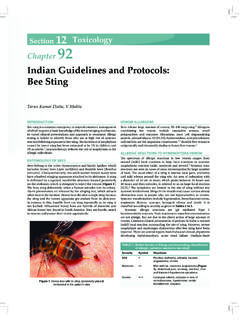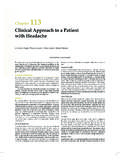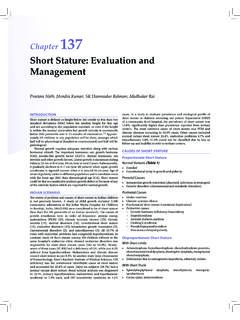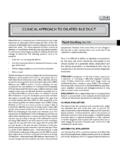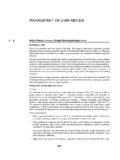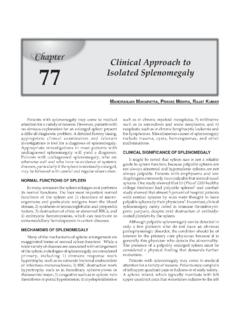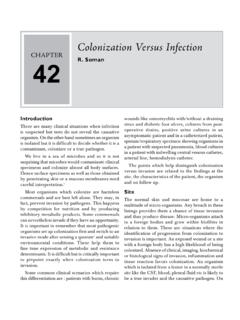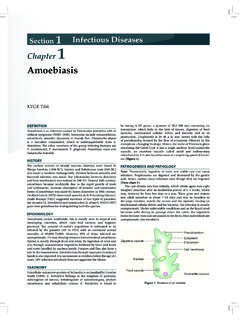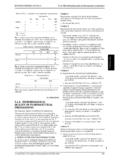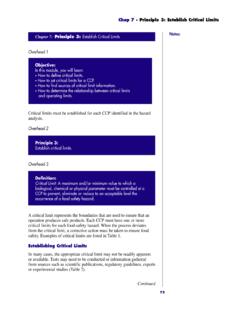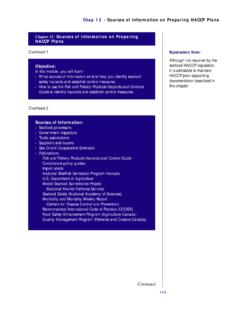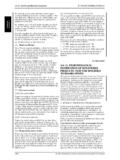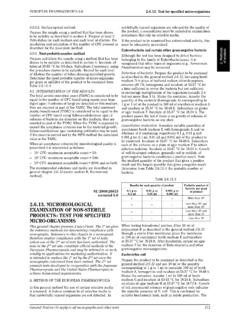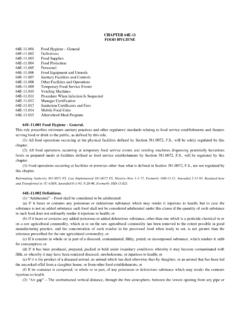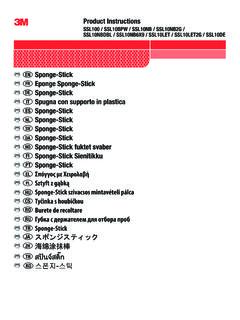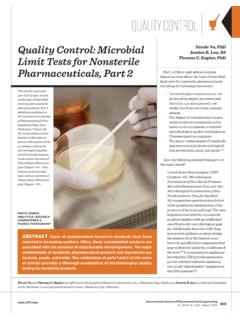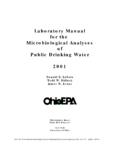Transcription of Chapter 13
1 Manifestation of NTM disease is lung disease (94%), but lymphatic (3%), skin/soft tissue and disseminated disease (3%) are also important. The important NTMs are M. kansasii, M. xenopi, M. fortuitum-chelonei complex and MAC. The MAC infections were commonly seen in pre-acquired immunodeficiency syndrome (pre-AIDS) era in patients with chronic obstructive pulmonary disease (COPD), bronchiectasis and occupational lung diseases like silicosis, etc. However, MAC infections are now classically seen in AIDS when CD4 count goes below 50/mm3. M. genavense is a new atypical agent seen in AIDS important observations have been made regarding pathogen-esis of NTM In patients infected with human immunodeficiency virus (HIV), disseminated NTM infections typically occurred only after the CD4 T lymphocyte number had fallen below 50/ L, suggesting that specific T cell products or activities are required for mycobacterial In the HIV-uninfected patient group, genetic syndromes of disseminated NTM infection have been associated with specific mutations in different genes, viz.
2 Genes responsible for interferon (IFN)- and inter leukin (IL)-12 synthesis along with their subunits and receptors [(IFN- receptor 1 (IFN- R1), IFN- receptor 2 (IFN- R2), IL-12 receptor b1 subunit (IL-12 b R1), the IL-12 subunit p40 (IL-12 p40)] Genes responsible for synthesis of the signal transducer and activator of transcription 1 (STAT1), and the nuclear factor kb essential modulator (NEMO)3. There is also an association between bronchiectasis, nodular pulmonary NTM infections and a particular body habitus, pre-dominantly in postmenopausal women ( pectus excavatum, scoliosis, mitral valve prolapse).)
3 Host Defense and Immune ResponseMycobacteria are initially phagocytosed by macrophages, which respond with production of IL-12, which in turn, upregulates IFN- . IFN- activates neutrophils and macro phages to kill intracellular pathogens, including mycobacteria. There is a positive feedback loop between IFN- and IL-12, which is critical for the control of mycobacteria, as well as certain other intracellular infections. Disseminated NTM disease is a definite manifestation of immunologic defect, either acquired, such as HIV and iatrogenic factors, or genetic caused by defects in the above IFN- /IL-12 pathway genes.
4 However, these genetic factors only predispose to disseminated Mycobacterial InfectionDebasis Chakraborty, Shankha S SenChapter 13 INTRODUCTIONA typical mycobacteria are also called nontuberculous mycobacteria (NTM) or mycobacteria other than tuberculosis (MOTT). Nontuberculous mycobacteria are widely distri buted in the environment with high isolation rates worldwide. They are divisible into two main groups: (1) the slow grower and (2) the rapid grower, according to their rate of growth on subculture. Most of the slow growers are able to cause human disease, the most common being two members of the M.
5 Avium complex (MAC), M. avium avium and M. avium intracellulare. With rare exceptions, only pathogenic rapid growers are M. abscessus, M. chelonae and M. OF NONTUBERCULAR MYCOBACTERIASlow growers Photochromogens M. kansasii M. marinum M. simiae Scotochromogens M. scrofulaceum M. gordonae M. avium Nonchromogens M. avium intracellulare M. xenopi M. ulcerans M. terrae M. malmoenseRapid growers M. fortuitum M. chelonae M. smegmatis M. abscessusEPIDEMIOLOGYN ontuberculous mycobacteria are ubiquitous in environment. In India, Mycobacterium tuberculosis infection has always over-shadowed true prevalence of NTM.
6 Although the exact magnitude of NTM is difficult to predict as culture is not a routine part of diagnosing tuberculosis (TB) in India, it varies from 1% to 28%. There is no evidence of animal-to-animal or human-to-human transmission of NTM. Human disease is suspected to be acquired from environmental exposures, although the specific source of infection usually cannot be identified. The most common clinical 54 Infectious DiseasesSection 1 Pulmonary DiseaseLung disease due to NTM occurs commonly in structural lung disease, such as COPD, bronchiectasis, cystic fibrosis (CF), pneumoconiosis, prior TB, pulmonary alveolar proteinosis and esophageal motility disorders.
7 Abnormal CF genotypes and alpha-1-antitrypsin (AAT) phenotypes may predispose some patients to NTM infection. Nontuberculous mycobacteria lung disease also occurs in women without clearly recognized predisposing factors. Bronchiectasis and NTM infection, usually MAC, often coexist, making causality difficult to determine. These patients may carry multiple MAC strains over time, suggesting either polyclonal infection or recurrent infection with distinct strains. It is unclear whether this problem is due to local abnormalities ( bronchiectasis) or due to immune defects. In one study from Japan, 170 patients with MAC lung infection were studied.
8 Of 622 siblings of those patients, 3 had MAC lung disease. The implication is that, the sibling risk for MAC infection is much higher than previously estimated population MorphotypeWomen with nodular NTM pulmonary infections associated with bronchiectasis have similar clinical characteristics and body type, sometimes including scoliosis, pectus excavatum, mitral valve prolapse and joint hypermobility. These pheno typic characteristics may represent markers for specific genotypes that affect both body morphotype and NTM infec tion susceptibility. Alternatively, the morphotype itself may influence mycobacterial infection susceptibility through poor tracheobronchial secretion drainage or ineffective mucociliary Necrosis Factor InhibitionInterferon- and IL-12 control mycobacteria in large part through the upregulation of tumor necrosis factor (TNF)-a, made predominantly by monocytes/macrophages.
9 The critical role of TNF-a in controlling intracellular infections is made clear through the use of TNF-a blocking agents. The potent TNF-a blocking antibodies infliximab, adali mumab and the soluble receptor etanercept are effective anti-inflammatory agents and lead to relatively high rates of development of active TB in those who are latently infected. The onset of TB after administration of infliximab ranges from weeks to months. In addition to TB, the TNF-a blocking agents predispose to invasive fungal infections, such as aspergillus, histoplasmosis and coccidioidomycosis.
10 Infections with mycobacteria and fungi are seen with all three agents, but significantly more with infliximab than etanercept. Adalimumab should be regarded as having similar risks. The risk posed by TNF-a blocking agents for predisposing to NTM infections or promoting progression of active NTM infection is unknown. Until more information is available, expert opinion is that patients with active NTM disease should receive TNF-a blocking agents only if they are also receiving adequate therapy for the NTM PRESENTATIONN ontubercular mycobacteria cause four main types of diseases: (1) chronic pulmonary, (2) lymphadenitis, (3) post inoculation and (4) disseminated.
